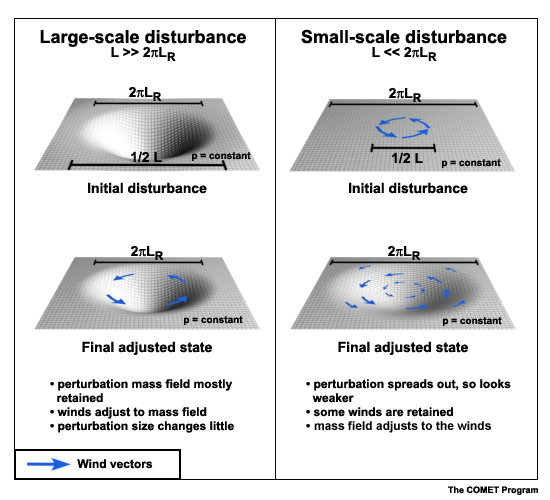

The key to the response is whether the disturbance is much wider, comparable to, or much less than the Rossby radius of deformation. The Rossby radius is related to the distance a gravity wave propagates before the Coriolis effect becomes important. Essentially, the gravity waves are able to disperse across this distance, as seen by the wiggly height pattern in the middle frame of the animation on the previous page. The gravity waves leave behind an adjusted state, as seen on the last frame, but they are unable to disperse across a broader distance, leaving areas beyond this distance unchanged.
![]()
|
Ways to conceptualize Rossby radius |
Consequences |
|
The scale at which rotation becomes as important as buoyancy |
|
|
The partitioning of potential vorticity (PV) into vorticity (winds) and static stability (mass). (Remember, PV is conserved if potential temperature is conserved. Thus, ignoring latent heating, radiation, and turbulence for the moment, the disturbance PV would be conserved during adjustment.) |
|
|
Partitioning between potential and kinetic energy |
|
The disturbance wavelength (crest-to-crest) L
gets compared to ![]() .
.
This (2![]() LR)
is the distance the gravity wave could travel during an inertial period, which,
in turn, is the amount of time it would take for an ageostrophic wind vector
to completely pivot around a circle as a result of being turned by the Coriolis
effect.
LR)
is the distance the gravity wave could travel during an inertial period, which,
in turn, is the amount of time it would take for an ageostrophic wind vector
to completely pivot around a circle as a result of being turned by the Coriolis
effect.
For disturbances of intermediate scale, the result is between these extremes.
| The disturbance wavelength (crest-to-crest)
L gets compared to This (2 For disturbances of intermediate scale, the result is between these extremes. |
 |
![]()